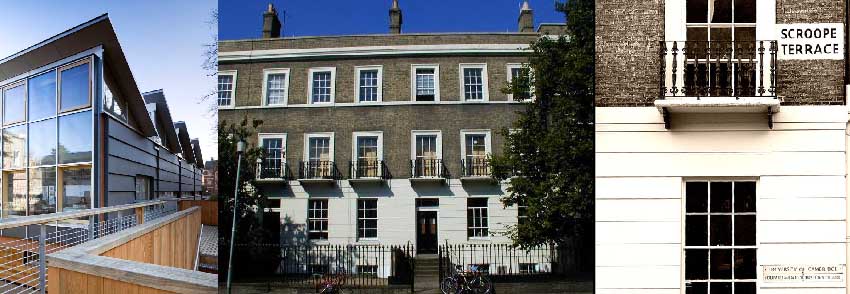
The Faculty of Architecture and Fine Arts was established after the First World War, with the division of the Faculty into two departments – Architecture and History of Art – occurring later during the 1970s. Together the two departments form one of the eight Faculties within the University’s School of Arts and Humanities.
The Buildings
Scroope Terrace, an elegant Victorian terrace and a listed building, is the home of the Faculty of Architecture and History of Art and was built in two stages; numbers 1 to 7 were built in 1839 and numbers 8 to 12 in 1864 in a style uniform with that of the 1839 building. Despite alterations, much of the original building remains as it was and in the Library you can still see original plaster cornices with neo-Greek ornament. The School of Architecture moved to 1 to 3 Scroope Terrace in 1924 and expanded in the 1950s and 1960s to take over numbers 4 and 5 as well. Today, 1 to 5 Scroope Terrace is shared by both of the Departments.
In 1958-9 an extension was constructed behind 1 Scroope Terrace to provide more space for the expanding Faculty. The extension was designed by the then First Year Master, and later Professor, Colin St John Wilson and another member of staff, Alex Hardy, who was responsible for overseeing certain technical aspects of the work. The building was designed in line with the principles of Le Corbusier’s Modulor system and was opened by Le Corbusier himself, along with the sculptor Henry Moore, after they both received their honorary degrees in June 1959.
Until 2000 the Faculty garden contained a geodesic dome of the type devised by Buckminster Fuller. This dome was erected in 1964 in order to accommodate an artificial sky for predicting natural lighting conditions in buildings.
The Teaching of Architecture
The teaching of architecture was established in 1912 after the Slade Professor, the distinguished Arts and Crafts architect and scholar Edwin Schroder Prior, persuaded the University to establish a Board of Architectural Studies. Prior’s finest building is perhaps the church of St Andrew, Roker, Sunderland and his best known book is The Cathedral Builders.
In the 1950s the University established a committee to review the teaching of architecture at Cambridge, and it was this committee that persuaded the University to expand the subject. As a result, Leslie Martin was appointed as the first Professor of Architecture and the University increased the resources available to the Faculty.
Professor Flora Samuel is the current Head of Department.
The Teaching of History of Art
Originally, fine art was only taught at Cambridge through occasional lectures. In 1869 an endowment from Felix Slade established a Chair in Fine Art, with the holder being required to deliver an annual series of public lectures. This Chair became known as the Slade Professorship and was originally elected for life. However, since 1960 the Slade Professor has been elected for one year only. The election is carried out by a Board of Electors on which both of the Departments are represented. (For a list of past and current Slade Professors see the History of Art departmental website.)
After the Second World War the history of art came to be taught as a set of papers in the Architecture and Fine Arts Tripos. This is thanks to Michael Jaffe, Lecturer in Fine Arts in 1961, who along with support from Sir Leslie Martin, the Professor of Architecture, started Tripos teaching for the Fine Arts. The History of Art Tripos was gradually established within the Faculty between 1961 and 1971. In 1970 the Department of History of Art was finally set up within the Faculty of Architecture and History of Art with Michael Jaffe as Head of Department, and a one-part History of Art Tripos was established. Michael Jaffe then went on to become ad hominem Professor in 1973 when he became Director of the Fitzwilliam Museum. The full three-year Tripos began in 1999.
Professor Alexander Marr is the current Head of Department.
